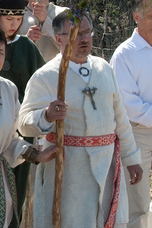Jonas Vaiškūnas
Jonas Vaiškūnas | |
|---|---|
 Vaiškūnas during a Romuva procession | |
| Born | 6 March 1961 |
| Nationality | Lithuanian |
| Occupation(s) | ethnoastronomer, physicist, museologist, publisher, vaidila |
| Spouse | Daiva Vaiškūnienė |
Jonas Vaiškūnas (born 6 March 1961) is a Lithuanian ethnoastronomer, physicist, museologist, publisher and priest in the Baltic neopagan organisation Romuva.
Biography
Jonas Vaiškūnas was born in the village Papiškė in Švenčionys District Municipality. He graduated from the physics department of Vilnius University in 1984. In the 1980s he worked in the physics department at the Lithuanian Academy of Sciences. Since 1990 he works at the Lithuanian Museum of Ethnocosmology in Molėtai, initially as a researcher and museologist, and since 1999 as the head of the museum.[1]
He is a vaidila (priest) in the Baltic neopagan organisation Romuva.[2] In 2012 he published a book about the Lithuanian zodiac.[3] The zodiac has only survived in fragmentary attestations, which Vaiškūnas used in an attempt to reconstruct it. It is closely related to the standard Western zodiac but also has culture-specific elements.[4] Vaiškūnas has been interviewed in the Lithuanian media in his role as ethnoastronomer during calendar holidays and celestial phenomena.[5][6][7]
Personal life
Vaiškūnas is married to the mathematician Daiva Vaiškūnienė. They have three daughters.[1]
References
- ^ a b "Jonas Vaiškūnas: Kandidato biografija" (in Lithuanian). Lietuvos Respublikos vyriausioji rinkimų komisija [The Central Electoral Commission of the Republic of Lithuania]. Retrieved 5 April 2020.
- ^ Pranskevičiūtė, Rasa (2013). "Contemporary Paganism in Lithuanian Context: Principal Beliefs and Practices of Romuva". In Aitamurto, Kaarina; Simpson, Scott (eds.). Modern Pagan and Native Faith Movements in Central and Eastern Europe. London and New York: Routledge. p. 81. ISBN 978-1-84465-662-2.
- ^ "Lrytas.lt biblioteka: 838. J. Vaiškūnas. 'Skaitant dangaus ženklus'". Lietuvos rytas (in Lithuanian). 14 November 2012. Retrieved 5 April 2020.
- ^ Saukienė, Inga (24 February 2013). "Mūsų protėviai turėjo savo Zodiako ženklų sistemą". Delfi (in Lithuanian). Retrieved 5 April 2020.
- ^ Jursevičius, Deividas (23 June 2014). "Ką iš tikrųjų reiškia paparčio žiedas ir kaip jį rasti". Vilniaus diena (in Lithuanian). Retrieved 5 April 2020.
- ^ Siavris, Edita (30 December 2017). "Ką reikia suspėti padaryti iki Naujųjų?". Vakarų ekspresas (in Lithuanian). Retrieved 5 April 2020.
- ^ Jalianiauskienė, Vitalija (31 December 2017). "Vertingos dangaus pamokos". Sekundė (in Lithuanian). Retrieved 5 April 2020.
External links
- Personal website (in Lithuanian)
